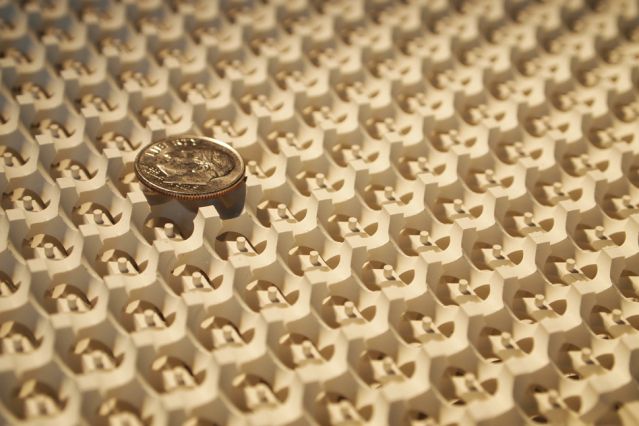Les fermion "massless" (sans masse) a donc été détecté. Le côté sans masse, s'il est avéré, est zarb chez les fermions (zarb² Wikipedia ne parle pas du fermion de Weyl)
J'avoue n'avoir RIEN COMPRIS du comment ils l'ont détecté, zéro absolu, surface gyroïde, photon déviés ?
Donc,
Il traverse tout l'univers
Aussi vite que la lumière
Qui est-il ? D'où vient-il ?
Formidablerobot
Des temps nouveauxIl jaillit du fond de la mer
Il bondit jusqu'à Jupiter
Qui est-il ? D'où vient-il ?
Ce terrible géant
Des nouveaux temps
Mais voilà, c'est fait.
Source:

Pour observer le fermion de Weyl, les chercheurs du MIT se sont appuyés sur un cristal structuré en gyroïde, ici surmonté d'une pièce de monnaie. © Ling Lu et Qinghui Yan
futura-sciences.com
Une explication sur le Wikipedia Anglais: il y a bien 2 types de fermions dans le modèle standard. Mais c'est dans le modèle mathématique d'Hermann Weyl qui parlent/théorise des spinors (spineurs en Français). Là je suis perdu dans les Wikipedia *need un mathématico-physico-vulgaro-explication* ;)
Elementary fermions
The Standard Model recognizes two types of elementary fermions, quarks and leptons. In all, the model distinguishes 24 different fermions. There are six quarks (up, down,strange, charm, bottom and top quarks), and six leptons (electron, electron neutrino,muon, muon neutrino, tau particle and tau neutrino), along with the correspondingantiparticle of each of these.
Mathematically, fermions come in three types - Weyl fermions (massless), Dirac fermions (massive), and Majorana fermions (each its own antiparticle). Most Standard Model fermions are believed to be Dirac fermions, although it is unknown at this time whether the neutrinosare Dirac or Majorana fermions. Dirac fermions can be treated as a combination of two Weyl fermions.[3]:106